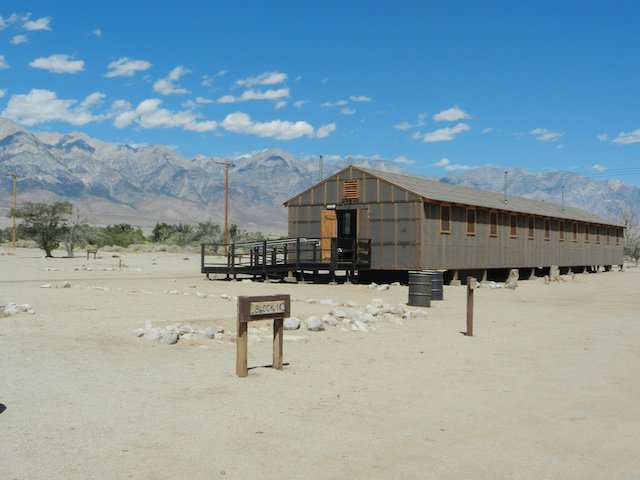INDEPENDENCE — The harsh treatment of 120,000 loyal Americans of Japanese ancestry is highlighted at the Manzanar National Historic Site, seven miles south of Independence in the Owens Valley along Highway 395.
It was one of 10 hastily constructed relocation centers that the federal government built. They were the result of President Franklin Roosevelt’s executive order two months after the bombing of Pearl Harbor. The President ordered Americans of Japanese ancestry on the West Coast to be forcibly moved out of fear they might commit potential sabotage and espionage.
It was done in a matter of days without due process and with very little time for those relocated to get their affairs in order. They left behind thriving farms, businesses, homes, pets, and virtually all of their worldly possessions.
The site’s main attractions are the 8,000-square-foot visitors’ center that was used as a community hall as well as two restored housing barracks that were among those that housed 11,700 internees at the desolate center. There is also one guard tower that was reconstructed as well as signs that mark the 500-acre housing section that was surrounded by barbed wire and eight guard towers.
The center documents the hysteria and fear whipped up by politicians and pundits in the dark days following Dec 7, 1941.
It touches on the lone Japanese submarine attack on a Southern California oil refinery and a subsequent false alarm of an aerial attack on Los Angeles that was reported widely as an actual mainland aerial bombing that finally triggered the executive order to send all Japanese Americans to relocation camps.
It documents how the internees were law-abiding Americans, many second and third generation Americans. It is noted not one Japanese American was ever formally charged or let alone convicted of espionage. Displays note that 5,000 Japanese Americans on the mainland and in Hawaii rushed to join the military after Pearl Harbor. Those 5,000 — along with 5,000 already in the military — served with distinction in January 1942, however, the Selective Service reclassified Japanese Americans as “enemy aliens” and stopped drafting them and allowing them to volunteer. Ironically when the draft for Japanese Americans was reinstated in January 1944, the 442nd Regimental Combat Team formed primarily with Japanese American volunteers and draftees fought with distinction in North Africa, France and Italy. With 9,846 casualties, it had the highest casualty rate and was the most decorated Army unit for its size and length of service.
Some 26,000 Japanese Americans served in the military during World War II.
The visitors’ center also encourages people browsing exhibits to ponder the issues of liberty, freedom and security.
You also get an idea of what their lives were like before Manzanar and what it was like living there.
And while visitors center displays of the primitive furniture they were issued with hay mattresses give you an inkling of what life was like, you need to walk through the barracks-like housing to get a true feel.
The wooden structures were ineffective at keeping dust or the cold out. Rain managed to seep into cracks and crevices.
Summer temperatures soared to 110 degrees while winter lows often dipped below freezing. Strong winds blanketed the camp with dust and sand.
Eight people — relatives or not — were crammed into allotted 20- by 25-foot rooms. Each room had an oil burning stove, a single hanging light bulb, cots, blankets and mattresses filled with straw. They were the only furnishings provided.
The communal latrines had no partitions and the showers had no stalls.
The camp included hospitals, mess halls, libraries, work centers where women volunteered to manufacture camouflage netting for American forces, gardens, and a cemetery among other features.
Manzanar was originally a town named after the Spanish word for “apple orchard”. It was a teeming orchard growing away until Los Angeles started diverting water from the Owens Valley. Manzanar’s elevation is 3,727 feet. To the west the Sierra rises abruptly with the highest peak being Mt. Williamson at 14,380 feet looming high on the horizon beyond Manzanar.
Currently due to COVID-19 the visitors’ center as well as the Block 14 exhibits such as the barracks, latrine, mess hall, and fire station are closed. The grounds and parking lot remain open from sunrise to sunset. The grounds include the gardens and cemetery along with an auto tour road.
There is no admission fee to the visitors’ center or grounds.
Once restrictions lift it is worth a visit when traveling to — or vacationing in — the eastern Sierra. It is a five-plus hour drive from this part of the Central Valley via Highway 120 to Highway 395 when snow removal allows the reopening of Tioga Pass later this spring.
The visitors’ center also has a theater that shows the 22-minute film “Remembering Manzanar.”
For more information go to www.nps.gov/manz/index.htm







